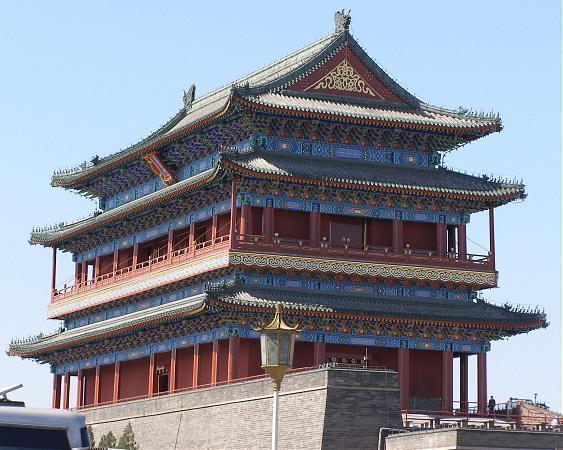Zhengyangmen, also known as the “Gate of the Zenith Sun” or commonly referred to as Qianmen, is a historic gatehouse located at the southern end of Tiananmen Square in Beijing, China. It is one of the most iconic landmarks in the city, with a rich history dating back over 600 years. Zhengyangmen has witnessed centuries of political, social, and cultural changes, making it a symbol of Beijing’s enduring legacy and cultural heritage.
Originally built during the Ming Dynasty (1368-1644 AD) in 1419, Zhengyangmen served as one of the nine gateways in the massive defensive walls that surrounded the ancient city of Beijing. Its strategic location at the southern entrance of the city made it a vital component of the capital’s fortifications, providing access to the imperial city and protecting against potential invasions.
The gatehouse itself is a grand structure characterized by its imposing facade, towering watchtowers, and intricate architectural details. It consists of a central archway flanked by two smaller gates, each adorned with ornamental carvings, inscriptions, and decorative motifs. The roof is crowned with traditional Chinese-style eaves, upturned corners, and decorative finials, adding to the gatehouse’s majestic appearance.
Throughout its history, Zhengyangmen has undergone several renovations and reconstructions, reflecting the changing needs and priorities of successive dynasties. However, it has retained much of its original architectural integrity and cultural significance, making it one of the best-preserved ancient gatehouses in Beijing.
Zhengyangmen played a crucial role in the defense of Beijing during times of war and conflict. In 1644, during the transition from the Ming Dynasty to the Qing Dynasty, the gatehouse was breached by Li Zicheng’s rebel forces, leading to the downfall of the Ming Dynasty and the establishment of the Qing Dynasty. The event marked a significant turning point in Chinese history and had far-reaching consequences for the country’s political landscape.
In addition to its military significance, Zhengyangmen also served as a ceremonial and administrative center for the imperial court. It was the starting point of the Imperial Way, a grand ceremonial avenue that led northward to the Forbidden City, where the emperor’s palace was located. The gatehouse was often used for state processions, official receptions, and other important ceremonies, showcasing the majesty and power of the imperial court.
Throughout the centuries, Zhengyangmen has witnessed many changes in Beijing’s urban landscape and cultural identity. With the expansion of the city and the construction of new roads and infrastructure, the gatehouse gradually lost its strategic importance and fell into disrepair. However, in recent decades, efforts have been made to preserve and restore Zhengyangmen as a historical and cultural landmark.
Today, Zhengyangmen stands as a symbol of Beijing’s rich history and cultural heritage, attracting visitors from around the world who come to admire its grandeur, learn about its storied past, and appreciate its architectural beauty. The gatehouse is surrounded by bustling streets, vibrant markets, and modern developments, creating a unique juxtaposition of ancient and contemporary elements that reflects Beijing’s dynamic and ever-evolving character.
In conclusion, Zhengyangmen is not just a historic gatehouse but also a symbol of Beijing’s enduring legacy and cultural heritage. As one of the city’s most iconic landmarks, it serves as a reminder of China’s rich history, architectural prowess, and cultural contributions to the world. Whether viewed from afar against the backdrop of Tiananmen Square or explored up close amidst its towering walls and majestic archways, Zhengyangmen continues to captivate the imagination and inspire awe in all who behold it.



